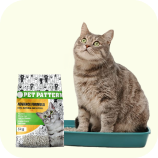Gingivitis in Cats: A Vet’s Guide to Symptoms, Treatment, and Prevention
Hey there, fellow cat lovers! Dr. Prerana here. As a veterinarian and a lifetime as cat parent, I’ve seen my fair share of dental issues in our furry friends. Today, I want to have a heart-to-heart chat about something I see almost daily in my practice: gingivitis in cats.
Let me start with a quick story. Last week, Mrs. Mahesh brought in her 7-year-old tabby, Oscar. She was worried because Oscar had become picky with his food and had “dragon breath” (her words, not mine!). When I examined Oscar, I found the telltale signs of cat gingivitis – red, inflamed gums that bled slightly when touched. Mrs. Mahesh was shocked when I explained that Oscar had been silently suffering from dental pain, possibly for months.
This scenario plays out in my clinic almost daily, and it breaks my heart because gingivitis in cats is both incredibly common and largely preventable. So grab a cup of coffee (or tea if that’s your thing), and let’s dive into everything you need to know about keeping your kitty’s mouth healthy and pain-free.
What Exactly Is Gingivitis in Cats?
Gingivitis in cats is inflammation of the gums (or gingiva – hence the name). It’s the earliest stage of periodontal disease in cats and, thankfully, it’s reversible if caught early. Think of it as the warning sign your cat’s body is sending before things get really serious.
In my years of practice, I’ve noticed that many cat parents don’t realize how common this condition is. Studies show that by age 3, about 70% of cats show signs of dental disease in cats, with gingivitis being the starting point. By age 5, that number jumps to over 85%! That’s a lot of kitties with sore mouths.
The thing about feline gingivitis is that it doesn’t just appear overnight. It develops gradually as plaque (that sticky film of bacteria) builds up along the gumline. If not removed, this plaque hardens into tartar (or calculus), which further irritates the gums and creates a perfect environment for more bacteria to thrive. It’s a vicious cycle that can lead to serious problems if we don’t intervene.
I remember treating a Maine Coon named Muffin whose owner thought cats naturally had “stinky breath.” When I showed her Muffin’s bright red, swollen gums, she was mortified to learn her beloved pet had been dealing with cat gingivitis for quite some time. The good news? After proper treatment and establishing a home care routine, Muffin’s mouth healed beautifully, and her breath improved dramatically.
Here Are Some Common Causes of Cat Gingivitis
Understanding the causes of cat gingivitis is the first step in prevention and treatment. In my practice, I’ve found several common culprits:
Plaque in cats is the primary villain in this story. Just like in humans, plaque is a biofilm of bacteria that forms on teeth within hours after eating. Without removal (through brushing or professional cleaning), plaque in cats hardens into tartar in cats within 24-72 hours. Once tartar forms, it can only be removed with professional dental instruments.
I often explain to pet parents that their cat’s mouth is like a garden – if you don’t weed regularly (brush their teeth), unwanted plants (bacteria) will take over and damage the landscape (gums and teeth).
Poor nutrition can also contribute to cat gingivitis. Cats fed exclusively soft food miss out on the natural cleaning action that occurs when chewing crunchy kibble. That said, diet alone isn’t enough to prevent dental disease – more on that later.
Some cats are genetically predisposed to dental issues. Certain breeds, like Persians, Siamese, and Maine Coons, seem to be more vulnerable to developing gum disease in cats. If you have one of these breeds, extra vigilance with dental care is warranted.
Age is another factor. Juvenile-onset gingivitis can affect cats as young as 6 months, while older cats often develop chronic gingivitis in cats due to years of plaque accumulation.
Perhaps most concerning are the systemic conditions that can manifest as feline gingivitis. Feline leukemia virus (FeLV) and feline immunodeficiency virus (FIV) can suppress the immune system, making cats more susceptible to infections, including those in the mouth. Kidney disease, diabetes, and autoimmune conditions can also contribute to cat oral disease.
I’ll never forget a case that taught me to look beyond the mouth. A young cat named Luna came in with severe gingivitis in cats that wasn’t responding to standard treatment. After running tests, we discovered she was FIV-positive. This diagnosis completely changed our treatment approach and likely saved her life by allowing us to address her compromised immune system.
Recognizing the Signs of Gingivitis in Cats
One of the biggest challenges with gingivitis in cats is that our feline friends are masters at hiding pain. By the time symptoms become obvious, the condition has often progressed significantly. That’s why knowing the subtle signs of gingivitis in cats is crucial.
The most common symptoms of gingivitis in cats include:
Red line along the gums: Healthy gums should be pink (though some cats naturally have pigmented gums). A red line where the teeth meet the gums is a classic sign of inflammation.
Swollen gums: Inflamed gums appear puffy and may bleed easily when touched. This is often one of the first visible signs of gingivitis in cats.
Bad breath in cats: While cat breath is never minty fresh, a sudden change or particularly foul odor can indicate dental problems. I often tell clients that if their cat’s breath makes them recoil, it’s time for a dental check-up.
Drooling: Excessive salivation, especially if the saliva is tinged with blood, can indicate cat gum disease.
Difficulty eating: Cats with sore mouths may approach their food eagerly but then back away, drop food, or chew on one side. Some cats with gingivitis in cats will switch from hard to soft food or stop grooming properly.
Pawing at the mouth: This can indicate oral discomfort and is a sign your cat needs veterinary attention.
Behavioral changes: Some cats become irritable or withdrawn when they’re in pain. If your normally social cat becomes a hermit, dental pain could be the culprit.
I remember a particularly heartbreaking case involving a senior cat named Shadow. His owner brought him in because he had stopped eating. During examination, I discovered severe gingivitis in cats that had progressed to periodontal disease in cats. Shadow’s owner was devastated, having mistaken his gradual weight loss and quieter demeanor as normal aging rather than signs of pain. After dental treatment, Shadow became a different cat – playful and engaged again, much to his owner’s amazement and relief.
This is why I’m so passionate about raising awareness of cat dental health. Our feline friends can’t tell us when their mouths hurt, so we need to be their advocates by recognizing these subtle signs.
The Connection Between Gingivitis and Periodontal Disease in Cats
It’s important to understand that gingivitis in cats is just the beginning of a potentially serious progression if left untreated. Let me walk you through how dental disease typically develops:
Stage 1: Gingivitis in cats – Inflammation is limited to the gums, with redness and swelling along the gumline. At this stage, the condition is completely reversible with proper treatment.
Stage 2: Early periodontal disease in cats – The inflammation begins to affect the structures that support the teeth. You might see early bone loss on dental X-rays, though the teeth remain firmly in place.
Stage 3: Moderate periodontal disease in cats – More significant bone loss occurs, and teeth may become loose. The gum tissue may recede, exposing sensitive tooth roots.
Stage 4: Advanced periodontal disease in cats – Severe bone loss leads to tooth mobility and eventual tooth loss. At this stage, cats experience significant pain and may develop systemic health issues.
I often use a house analogy with my clients. Gingivitis in cats is like noticing cracks in your foundation – address it quickly, and your house (teeth) will be fine. Ignore it, and eventually, the whole structure becomes compromised.
What many pet parents don’t realize is that periodontal disease in cats doesn’t just affect the mouth. The bacteria involved can enter the bloodstream and potentially damage the heart, kidneys, and liver. This is why dental care for cats isn’t just about fresh breath – it’s about overall health.
I’ve seen this connection firsthand with patients like Bella, a 12-year-old calico with a heart murmur. After treating her severe dental disease in cats, not only did her mouth heal, but her cardiac function improved as well. Her cardiologist and I agreed that reducing the bacterial load in her mouth likely decreased the strain on her heart.
Understanding Gingivitis vs Stomatitis in Cats
When discussing feline gingivitis, it’s important to mention a more severe condition called stomatitis. Understanding the difference between gingivitis vs stomatitis in cats can help you recognize when your cat needs immediate veterinary attention.
Gingivitis in cats primarily affects the gumline where it meets the teeth. Feline stomatitis, on the other hand, involves widespread, severe inflammation throughout the mouth, including the back of the throat, tongue, and inside of the cheeks. It’s essentially the mouth’s extreme inflammatory response, often to the presence of plaque.
While gingivitis in cats can usually be managed with dental cleanings and home care, feline stomatitis typically requires more aggressive treatment, sometimes including the extraction of all teeth to provide relief.
I recall a patient named Whiskers who came in with what the owner thought was simple cat gingivitis. Upon examination, I found the angry red inflammation characteristic of stomatitis extending well beyond the gumline. Whiskers was in such pain he could barely eat. After discussing options with his owner, we decided on full-mouth extractions. The transformation was remarkable – within weeks, Whiskers was pain-free and eating better than he had in years, despite having no teeth!
This case highlights why proper diagnosis is crucial. What might seem like gingivitis in cats could actually be a more serious condition requiring different treatment approaches.
Professional Treatment for Cat Gingivitis
When it comes to treatment for cat gingivitis, there’s no substitute for professional veterinary care. Let me walk you through what typically happens when you bring your cat in for dental issues:
First, I perform a conscious examination to assess the severity of the gingivitis in cats and check for other health issues. However, this only gives me part of the picture. To fully evaluate your cat’s dental health, a procedure under general anesthesia is usually necessary.
I know the mention of anesthesia makes many pet parents nervous. I was anxious too when my own cat, Milo, needed a dental cleaning! But I can assure you that modern veterinary anesthesia is very safe, especially when proper pre-anesthetic testing is performed. The risks of untreated dental disease in cats far outweigh the minimal risks of anesthesia.
During a professional cat dental cleaning, we:
Take dental X-rays to check for problems below the gumline (where 60% of dental disease lurks!)
Scale the teeth to remove plaque and tartar both above and below the gumline
Polish the teeth to smooth microscopic scratches that would otherwise attract more plaque
Apply a fluoride treatment or dental sealant in some cases
Extract any teeth that are severely affected by periodontal disease in cats and cannot be saved
After the procedure, I typically prescribe antibiotics if infection is present and pain medication to keep your cat comfortable during recovery. Some cases of gingivitis in cats may also benefit from anti-inflammatory medications.
The transformation after professional treatment of gingivitis in cats can be dramatic. I remember treating a rescue cat named Oliver whose mouth was so painful he could barely eat. His foster mom was concerned about his chances for adoption due to his “attitude problem.” After his dental procedure, which included removing several diseased teeth, Oliver became a different cat – playful, affectionate, and quickly adopted into a loving home. His “attitude problem” had simply been pain that he couldn’t communicate.
How to Treat Gingivitis in Cats at Home?
While professional care is essential, knowing how to treat gingivitis in cats at home is equally important for long-term management. Here’s my practical advice based on years of treating feline dental issues (and wrestling with my own cats for tooth brushing!):
Tooth brushing: This is the gold standard for preventing plaque in cats. Use a cat-specific toothbrush or finger brush with pet-safe toothpaste (never human toothpaste, which contains harmful ingredients for cats). Start slowly, making it a positive experience with lots of praise and perhaps treats afterward.
I’ll be honest – when I first tried brushing my cat Jasper’s teeth, it was a disaster! He ran at the mere sight of the toothbrush. I had to start by just touching his lips, then gradually introducing the brush over several weeks. Now he tolerates it for about 30 seconds, which is enough to make a difference. Progress, not perfection!
Dental diets and treats: Several prescription diets are designed to reduce plaque in cats through special kibble texture or ingredients that inhibit tartar formation. While not as effective as brushing, they can be a helpful addition to your cat dental care routine.
Dental water additives: These products can help reduce bacteria in your cat’s mouth when added to drinking water. Some cats may refuse to drink water with additives, so monitor water consumption if you try this approach.
Dental wipes and gels: For cats who won’t tolerate brushing, antimicrobial wipes or gels can help reduce bacteria along the gumline.
Regular monitoring: Check your cat’s mouth weekly for signs of gingivitis in cats, such as redness, swelling, or bad breath. Early intervention is key to preventing gingivitis in cats from progressing.
Remember that home care is most effective when started before dental disease develops. It’s much harder to reverse existing gingivitis in cats without professional intervention first.
I learned this lesson with my own cat, Luna. Despite my knowledge as a vet, I got busy and neglected her dental care for several months. When I finally checked her mouth, I was embarrassed to find early gingivitis in cats developing. It was a humbling reminder that even veterinarians’ pets need consistent care!
Special Considerations for Different Cats
Not all cases of gingivitis in cats are created equal. Various factors can influence both susceptibility and treatment approaches:
Age matters: Kittens and young cats may develop juvenile-onset gingivitis around the time their adult teeth erupt. This often improves with age but should still be monitored. Senior cats frequently have accumulated dental issues and may need more intensive care.
Daily Dental Care for Cats: Making It a Positive Experience
Effective treatment for cat gingivitis doesn’t end at the vet’s office. Dental care for cats needs to continue at home to prevent recurrence.
Implementing dental care for cats early in life makes the process much easier for both you and your feline friend. But even older cats can learn to accept it with patience and positive reinforcement.
Daily cat dental care doesn’t have to be complicated—even wiping your cat’s gums with a gauze pad can help. Here’s what I recommend to my clients:
Mastering Cat Teeth Brushing: Tips from a Vet
Successful cat teeth brushing depends on patience, the right tools, and positive reinforcement. Here’s my step-by-step approach:
-
Start by getting your cat used to having their mouth touched. Gently lift their lip for a second, then reward with a treat. Do this for several days.
-
Introduce the toothpaste (must be formulated for cats – human toothpaste is toxic to them). Let them lick a small amount from your finger as a treat.
-
Put a small amount of toothpaste on your finger and briefly rub it on one or two teeth. Reward lavishly.
-
Gradually introduce a cat toothbrush or finger brush, starting with just one or two teeth and working up to the full mouth.
-
Focus on the outer surfaces of the teeth – cats’ tongues actually do a decent job cleaning the inner surfaces.
-
Keep sessions short (30 seconds to a minute) and positive.
I always laugh remembering my own journey teaching my cat Whiskers to accept tooth brushing. The first attempt ended with toothpaste on my ceiling (how did he even do that?). But with persistence, he eventually accepted it as part of our routine.
Maintaining Optimal Cat Dental Health Through Diet and Care
Good cat dental health contributes significantly to your pet’s overall wellbeing and longevity. Beyond brushing, there are other ways to support your cat’s dental wellness:
Cat Dental Products: What Actually Works?
There are numerous cat dental products on the market, from specialized toothpastes to dental treats and toys. But which ones actually help prevent gingivitis in cats?
In my experience, these products can be helpful supplements to (but not replacements for) brushing:
-
Dental diets (prescription diets specifically formulated to reduce plaque)
-
Dental treats (look for the Veterinary Oral Health Council seal of approval)
-
Water additives that help reduce bacteria
-
Dental gels containing chlorhexidine or zinc
-
Dental wipes for cats who won’t tolerate brushing
I recommend dental products as part of a comprehensive approach to cat dental care. My own cats get their teeth brushed three times a week, eat a dental diet, and get dental treats as rewards for good behavior (like tolerating tooth brushing!).
Preventing Gingivitis in Cats: Daily Habits That Make a Difference
As with most health issues, preventing gingivitis in cats is far easier and less expensive than treating advanced dental disease. The prevention of gingivitis in cats starts with establishing a regular dental care routine from kittenhood.
My top recommendations for preventing gingivitis in cats:
Brush your cat’s teeth daily, or at minimum 2-3 times weekly
Feed a diet that supports dental health (some dry foods or prescription dental diets)
Provide dental treats or toys approved by the Veterinary Oral Health Council
Schedule regular veterinary check-ups that include oral examinations
Have professional dental cleanings as recommended by your vet
I’ve seen the difference these habits make. Cats whose owners follow these recommendations consistently have significantly less gingivitis in cats and other dental problems than those who don’t.
One of my long-term clients has brushed her Maine Coon’s teeth since kittenhood. At 12 years old, her cat has needed only one professional dental cleaning and has minimal tartar buildup – quite remarkable for a breed prone to dental issues.
Special Cases: When Gingivitis Signals Something More Serious
Sometimes, gingivitis in cats can be a sign of other health issues that need attention.
Tooth Resorption in Cats: A Painful Complication
Tooth resorption in cats is a painful condition that can develop alongside chronic gingivitis. It involves the gradual destruction of the tooth from within, eventually causing the crown to break off while painful root fragments remain embedded in the gum.
This condition affects up to 60% of cats over 6 years old and is often discovered during dental examinations. The only effective treatment is the extraction of the affected teeth.
I diagnosed tooth resorption in my own cat, Mittens, during a routine examination. Despite showing no obvious signs of pain (typical cat!), the relief after extraction was evident in her increased playfulness and improved appetite.
Juvenile-Onset Gingivitis: Catching Problems Early
Some breeds are predisposed to juvenile-onset gingivitis, which requires early intervention. Oriental breeds like Siamese and Abyssinians seem particularly prone to developing severe gum inflammation at a young age.
I recently treated a young Siamese with juvenile-onset gingivitis so severe that we initially suspected an autoimmune condition. Aggressive early intervention with professional cleaning, daily home care, and anti-inflammatory medication helped get it under control before it progressed to irreversible periodontal disease.
Feline Stomatitis: When Inflammation Takes Over
Feline stomatitis represents an extreme inflammatory response that goes beyond typical gingivitis. This painful condition causes widespread inflammation throughout the mouth and throat.
Managing feline stomatitis often requires extraction of all teeth behind the canines (or sometimes all teeth) to eliminate the source of inflammation. While this sounds drastic, many cats with this condition experience dramatic improvement after extractions.
I remember a cat named Leo who had suffered with feline stomatitis for years. His owner had tried numerous treatments with limited success. After full-mouth extractions, Leo transformed from a cat who would cry when trying to eat to one who played, ate normally, and even groomed again. His owner told me, “I have my cat back.”
Managing Chronic Gingivitis in Cats: A Long-Term Approach
For some cats, especially those with underlying conditions like feline immunodeficiency virus, chronic gingivitis in cats becomes a long-term management issue rather than something that can be completely cured.
Managing chronic gingivitis in cats requires a consistent, long-term approach to dental care. This might include:
More Frequent Professional Cleanings: Your vet may recommend dental cleanings every 6–12 months to remove plaque and tartar buildup before it worsens.
At-Home Dental Care: Daily or regular tooth brushing with vet-approved toothpaste can make a big difference. If brushing isn’t possible, dental wipes or rinses may help.
Prescription Diets & Dental Treats: Some special dental diets and treats are designed to reduce plaque and tartar. Your vet can recommend the best options for your cat’s specific needs.
Regular Vet Checkups: Frequent dental checkups allow your vet to monitor your cat’s gums and catch any flare-ups early.
Medication Management: For cats with severe inflammation, your vet may prescribe antibiotics, anti-inflammatory medication, or immune-modulating drugs to help control symptoms.
Pain Management: Chronic gingivitis can be painful. If needed, your vet might suggest pain relief options to keep your cat comfortable.
Tooth Extractions (in Severe Cases): In some cases, if gingivitis progresses to severe periodontal disease, extraction of affected teeth may be necessary to reduce pain and ongoing infection.
Remember, patience and consistency are key. Many cats with chronic gingivitis can still live happy, comfortable lives with the right care plan in place. Regular communication with your vet will help you adjust your approach as needed to keep your feline friend healthy and pain-free.
Final Thoughts: A Healthy Mouth, A Happy Cat
Gingivitis in cats might be common, but it’s also one of the most preventable health issues I see in my practice. The biggest takeaway I hope you remember is this: your cat’s dental health is directly tied to their overall wellbeing and comfort.
A few minutes a week spent checking your cat’s mouth or brushing their teeth can spare them months—or even years—of silent suffering. Regular vet visits, professional cleanings when needed, and daily habits like using dental treats or wipes really do make a difference.
As a vet (and a fellow cat parent who’s wrestled more than a few toothbrushes away from stubborn kitties!), I know that perfection isn’t the goal—progress is. Even small steps, done consistently, help keep gingivitis at bay and your cat living their happiest, healthiest life.
If you ever notice changes in your cat’s breath, eating habits, or behavior, don’t shrug it off. A quick dental checkup could mean the difference between a minor fix and major dental disease down the line.
Your cat depends on you to be their advocate—so keep an eye on that smile! Thanks for reading, and give your kitty a chin scratch from me!
FAQs
Q: How do I treat gingivitis in my cat?
A: Treating gingivitis in cats usually involves professional dental cleaning to remove plaque and tartar. Your vet may also prescribe antibiotics or anti-inflammatory medications if an infection is present. At home, regular tooth brushing and dental treats can help maintain gum health. Severe cases may need further veterinary care.
Q: Do antibiotics cure gingivitis in cats?
A: Antibiotics can help manage bacterial infections linked to gingivitis, but they don’t cure the underlying cause permanently. Professional dental cleaning and ongoing oral care are needed to control plaque buildup. Without proper dental hygiene, gingivitis may return even after antibiotic treatment.
Q: Do cats need surgery for gingivitis?
A: Mild gingivitis rarely needs surgery, but severe or chronic cases may require tooth extractions, especially if gum disease has caused advanced damage. Your vet will evaluate the severity and recommend the best treatment plan, which often combines professional cleaning, medication, and possible dental surgery.
Q: What should I feed a cat with gingivitis?
A: Soft, easy-to-eat foods are best for cats with gingivitis to reduce gum irritation and pain. Wet food or softened kibble helps make eating more comfortable. Some dental diets can also help control plaque buildup. Always consult your vet for the best diet plan for your cat’s dental health.



 Golden Retriever
Golden Retriever
 German Shepherd
German Shepherd
 Labrador
Labrador
 Rottweiler
Rottweiler
 Beagle
Beagle
 Preventive Care
Preventive Care
 System wise
System wise
 Supplements
Supplements





























































































































































